steering MAZDA MODEL 3 HATCHBACK 2006 Quick Tips (in English)
[x] Cancel search | Manufacturer: MAZDA, Model Year: 2006, Model line: MODEL 3 HATCHBACK, Model: MAZDA MODEL 3 HATCHBACK 2006Pages: 12, PDF Size: 1.59 MB
Page 2 of 12
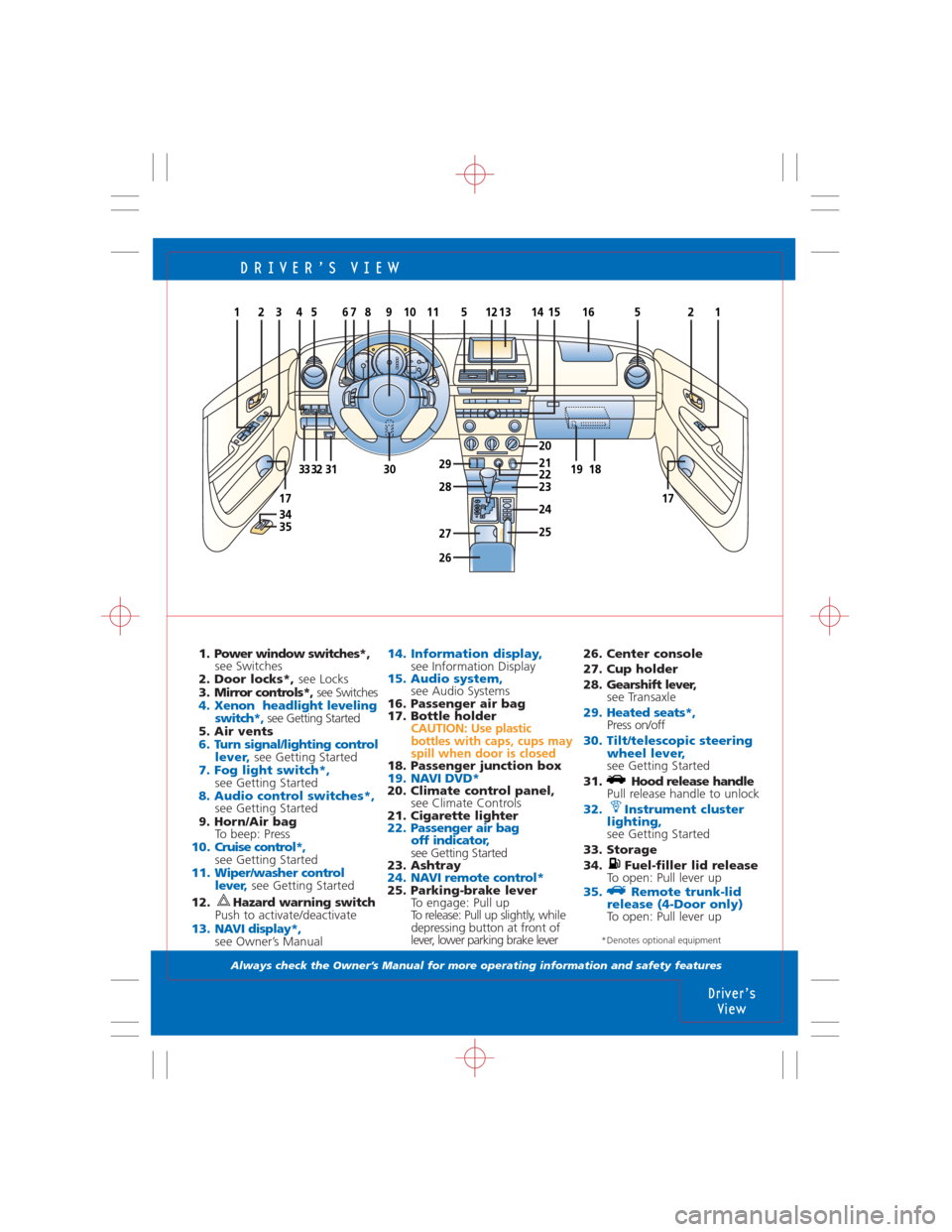
DRIVER’S VIEW
Always check the Owner’s Manual for more operating information and safety features
1. Power window switches*,
see Switches
2. Door locks*, see Locks
3. Mirror controls*, see Switches
4. Xenon headlight leveling
switch*,see Getting Started
5. Air vents
6. Turn signal/lighting control
lever, see Getting Started7. Fog light switch*,see Getting Started8. Audio control switches*,see Getting Started
9. Horn/Air bag
To beep: Press
10. Cruise control*, see Getting Started11. Wiper/washer control
lever,see Getting Started
12. Hazard warning switch
Push to activate/deactivate
13. NAVI display*,see Owner’s Manual
14. Information display,see Information Display15. Audio system,see Audio Systems
16. Passenger air bag
17. Bottle holder
CAUTION: Use plastic
bottles with caps, cups may
spill when door is closed
18. Passenger junction box19. NAVI DVD*20. Climate control panel,
see Climate Controls
21. Cigarette lighter
22. Passenger air bag
off indicator,
see Getting Started
23. Ashtray
24. NAVI remote control*25. Parking-brake lever
To engage: Pull up
To release: Pull up slightly, while
depressing button at front of
lever, lower parking brake lever
Driver’s
View
231
34
17
3527
28
2423
20
545166711513129108
30313332
21
17
1415
2625
1819212229
26. Center console
27. Cup holder
28. Gearshift lever,
see Transaxle
29. Heated seats*,Press on/off
30. Tilt/telescopic steering
wheel lever,
see Getting Started
31. Hood release handle
Pull release handle to unlock
32. Instrument cluster
lighting,
see Getting Started
33. Storage
34. Fuel-filler lid release
To open: Pull lever up
35. Remote trunk-lid
release (4-Door only)
To open: Pull lever up
*Denotes optional equipment
Page 3 of 12
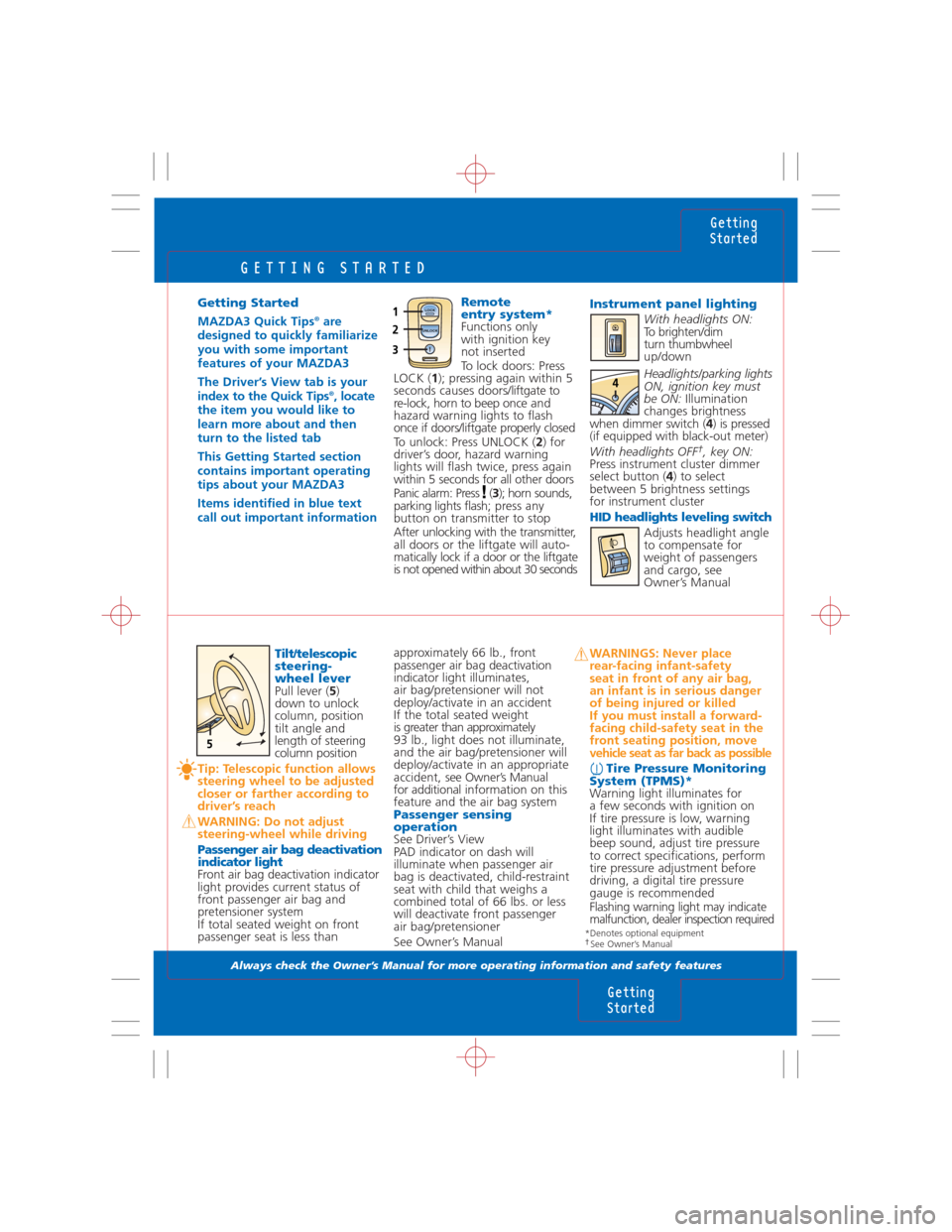
GETTING STARTED
Always check the Owner’s Manual for more operating information and safety features
Getting Started
MAZDA3 Quick Tips®are
designed to quickly familiarize
you with some important
features of your MAZDA3
The Driver’s View tab is your
index to the Quick Tips
®, locate
the item you would like to
learn more about and then
turn to the listed tab
This Getting Started section
contains important operating
tips about your MAZDA3
Items identified in blue text
call out important informationRemote
entry system*
Functions only
with ignition key
not inserted
To lock doors: Press
LOCK (1); pressing again within 5
seconds causes doors/liftgate to
re-lock, horn to beep onceand
hazard warning lights to flash
once if doors/liftgate properly closed
To unlock: Press UNLOCK (2) for
driver’s door, hazard warning
lights will flash twice, press again
within 5 seconds for all other doors
Panic alarm: Press (3); horn sounds,
parking lights flash; press any
button on transmitter to stop
After unlocking with the transmitter,
all doors or the liftgate will auto-
matically lock if a door or the liftgate
is not opened within about 30 seconds
Instrument panel lighting
With headlights ON:
To brighten/dim
turn thumbwheel
up/down
Headlights/parking lights
ON, ignition key must
be ON: Illumination
changes brightness
when dimmer switch (4) is pressed
(if equipped with black-out meter)
With headlights OFF
†, key ON:
Press instrument cluster dimmer
select button (4) to select
between 5 brightness settings
for instrument cluster
HID headlights leveling switch
Adjusts headlight angle
to compensate for
weight of passengers
and cargo, see
Owner’s Manual
approximately 66 lb., front
passenger air bag deactivation
indicator light illuminates,
air bag/pretensioner will not
deploy/activate in an accident
If the total seated weight
is greater than approximately
93 lb., light does not illuminate,
and the air bag/pretensioner will
deploy/activate in an appropriate
accident, see Owner’s Manual
for additional information on this
feature and the air bag system
Passenger sensing
operation
See Driver’s View
PAD indicator on dash will
illuminate when passenger air
bag is deactivated, child-restraint
seat with child that weighs a
combined total of 66 lbs. or less
will deactivate front passenger
air bag/pretensioner
See Owner’s Manual
Getting
Started
Getting
Started
4
WARNINGS: Never place
rear-facing infant-safety
seat in front of any air bag,
an infant is in serious danger
of being injured or killed
If you must install a forward-
facing child-safety seat in the
front seating position, move
vehicle seat as far back as possible
Tire Pressure Monitoring
System (TPMS)*
Warning light illuminates for
a few seconds with ignition on
If tire pressure is low, warning
light illuminates with audible
beep sound, adjust tire pressure
to correct specifications, perform
tire pressure adjustment before
driving, a digital tire pressure
gauge is recommended
Flashing warning light may indicate
malfunction, dealer inspection required
LOCK
UNLOCK1
2
3
Tilt/telescopic
steering-
wheel lever
Pull lever (5)
down to unlock
column, position
tilt angle and
length of steering
column position
Tip: Telescopic function allows
steering wheel to be adjusted
closer or farther according to
driver’s reach
WARNING: Do not adjust
steering-wheel while driving
Passenger air bag deactivation
indicator light
Front air bag deactivation indicator
light provides current status of
front passenger air bag and
pretensioner system
If total seated weight on front
passenger seat is less than
5
*Denotes optional equipment†See Owner’s Manual
Page 4 of 12
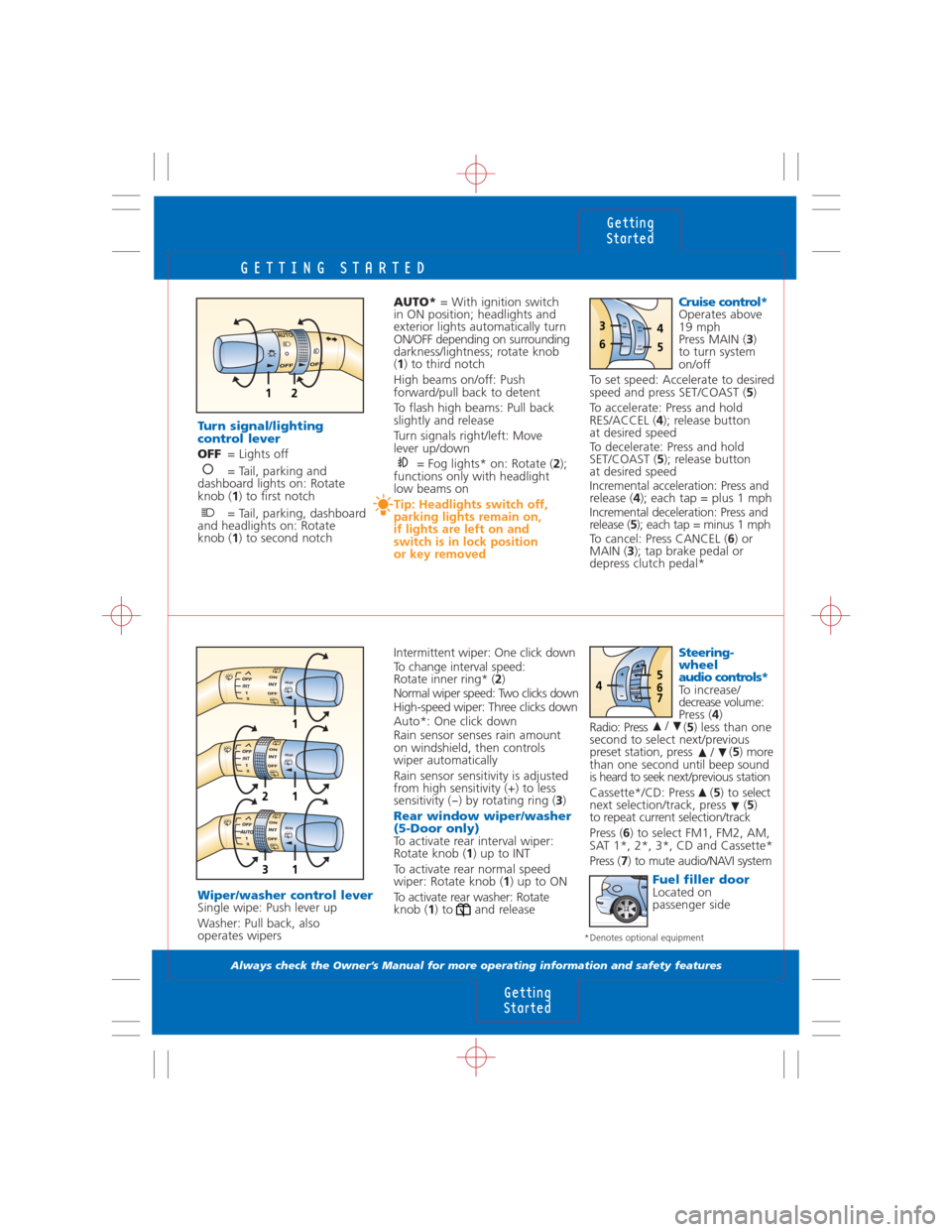
21
AUTO
GETTING STARTED
Always check the Owner’s Manual for more operating information and safety features
AUTO*= With ignition switch
in ON position; headlights and
exterior lights automatically turn
ON/OFF depending on surrounding
darkness/lightness; rotate knob
(1) to third notch
High beams on/off: Push
forward/pull back to detent
To flash high beams: Pull back
slightly and release
Turn signals right/left: Move
lever up/down
= Fog lights* on: Rotate (2);
functions only with headlight
low beams on
Tip: Headlights switch off,
parking lights remain on,
if lights are left on and
switch is in lock position
or key removed
Cruise control*Operates above
19 mph
Press MAIN (3)
to turn system
on/off
To set speed: Accelerate to desired
speed and press SET/COAST (5)
To accelerate: Press and hold
RES/ACCEL (4); release button
at desired speed
To decelerate: Press and hold
SET/COAST (5); release button
at desired speed
Incremental acceleration: Press and
release (4); each tap = plus 1 mph
Incremental deceleration: Press and
release (5); each tap = minus 1 mph
To cancel: Press CANCEL (6) or
MAIN (3); tap brake pedal or
depress clutch pedal*
REAR
1
REA
R
13
INT
REAR
12
INT
Intermittent wiper: One click down
To change interval speed:
Rotate inner ring* (2)
Normal wiper speed: Two clicks down
High-speed wiper: Three clicks down
Auto*: One click down
Rain sensor senses rain amount
on windshield, then controls
wiper automatically
Rain sensor sensitivity is adjusted
from high sensitivity (+) to less
sensitivity (
-) by rotating ring (3)Rear window wiper/washer
(5-Door only)
To activate rear interval wiper:
Rotate knob (1) up to INT
To activate rear normal speed
wiper: Rotate knob (1) up to ON
To activate rear washer: Rotate
knob (1) to and release
Getting
Started
Getting
Started
Steering-
wheel
audio controls*
To increase/
decreasevolume:
Press (4)
Radio: Press (5) less than one
second to select next/previous
preset station, press (5) more
than one second until beep sound
is heard to seek next/previous station
Cassette*/CD: Press (5) to select
next selection/track, press (5)
to repeat current selection/track
Press (6) to select FM1, FM2, AM,
SAT 1*, 2*, 3*, CD and Cassette*
Press (7) to mute audio/NAVI system
Fuel filler doorLocated on
passenger side
/
/
Turn signal/lighting
control lever
OFF= Lights off
= Tail, parking and
dashboard lights on: Rotate
knob (1) to first notch
= Tail, parking, dashboard
and headlights on: Rotate
knob (1) to second notch
Wiper/washer control leverSingle wipe: Push lever up
Washer: Pull back, also
operates wipers
M
O
D
EVOL465
7
ON
OFF
SET
RES
CANCEL
SET
COAST
3
64
5
*Denotes optional equipment
Page 5 of 12
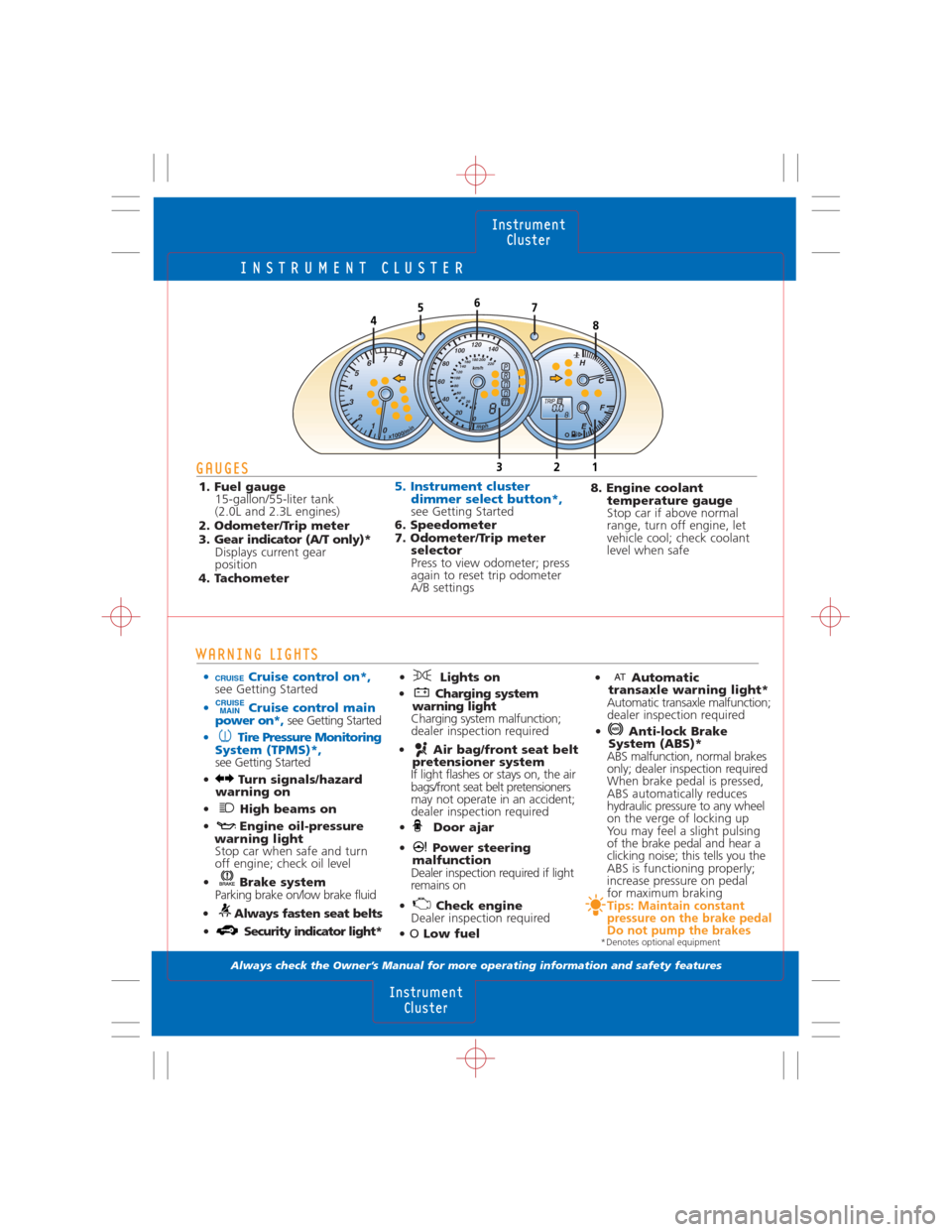
INSTRUMENT CLUSTER
Always check the Owner’s Manual for more operating information and safety features
WARNING LIGHTS
• Cruise control on*,see Getting Started
• Cruise control main
power on*,see Getting Started
• Tire Pressure Monitoring
System (TPMS)*,
see Getting Started
• Turn signals/hazard
warning on
• High beams on
• Engine oil-pressure
warning light
Stop car when safe and turn
off engine; check oil level
• Brake system
Parking brake on/low brake fluid
• Always fasten seat belts
• Security indicator light*
GAUGES
1. Fuel gauge
15-gallon/55-liter tank
(2.0L and 2.3L engines)
2. Odometer/Trip meter
3. Gear indicator (A/T only)*
Displays current gear
position
4. Tachometer
• Lights on
• Charging system
warning light
Charging system malfunction;
dealer inspection required
• Air bag/front seat belt
pretensioner system
If light flashes or stays on, the air
bags/front seat belt pretensioners
may not operate in an accident;
dealer inspection required
• Door ajar
• Power steering
malfunction
Dealer inspection required if light
remains on
• Check engine
Dealer inspection required
• OLow fuel5. Instrument cluster
dimmer select button*,
see Getting Started
6. Speedometer
7. Odometer/Trip meter
selector
Press to view odometer; press
again to reset trip odometer
A/B settings
Instrument
Cluster
Instrument
Cluster
nim/0001x
H
P
TRIPA80.0
RNDM8
C
F
E
5748
6
1 32
hpm
km/h
80220 200 180
160
140
120
100
60
40
20
0
0 20 40 6080100120
1400 1 2 3 4567
8
• Automatic
transaxle warning light*
Automatic transaxle malfunction;
dealer inspection required
• Anti-lock Brake
System (ABS)*
ABS malfunction, normal brakes
only; dealer inspection required
When brake pedal is pressed,
ABS automatically reduces
hydraulic pressure to any wheel
on the verge of locking up
You may feel a slight pulsing
of the brake pedal and hear a
clicking noise; this tells you the
ABS is functioning properly;
increase pressure on pedal
for maximum braking
Tips: Maintain constant
pressure on the brake pedal
Do not pump the brakes
8. Engine coolant
temperature gauge
Stop car if above normal
range, turn off engine, let
vehicle cool; check coolant
level when safe
CRUISE
MAIN CRUISE
*Denotes optional equipment
Page 12 of 12
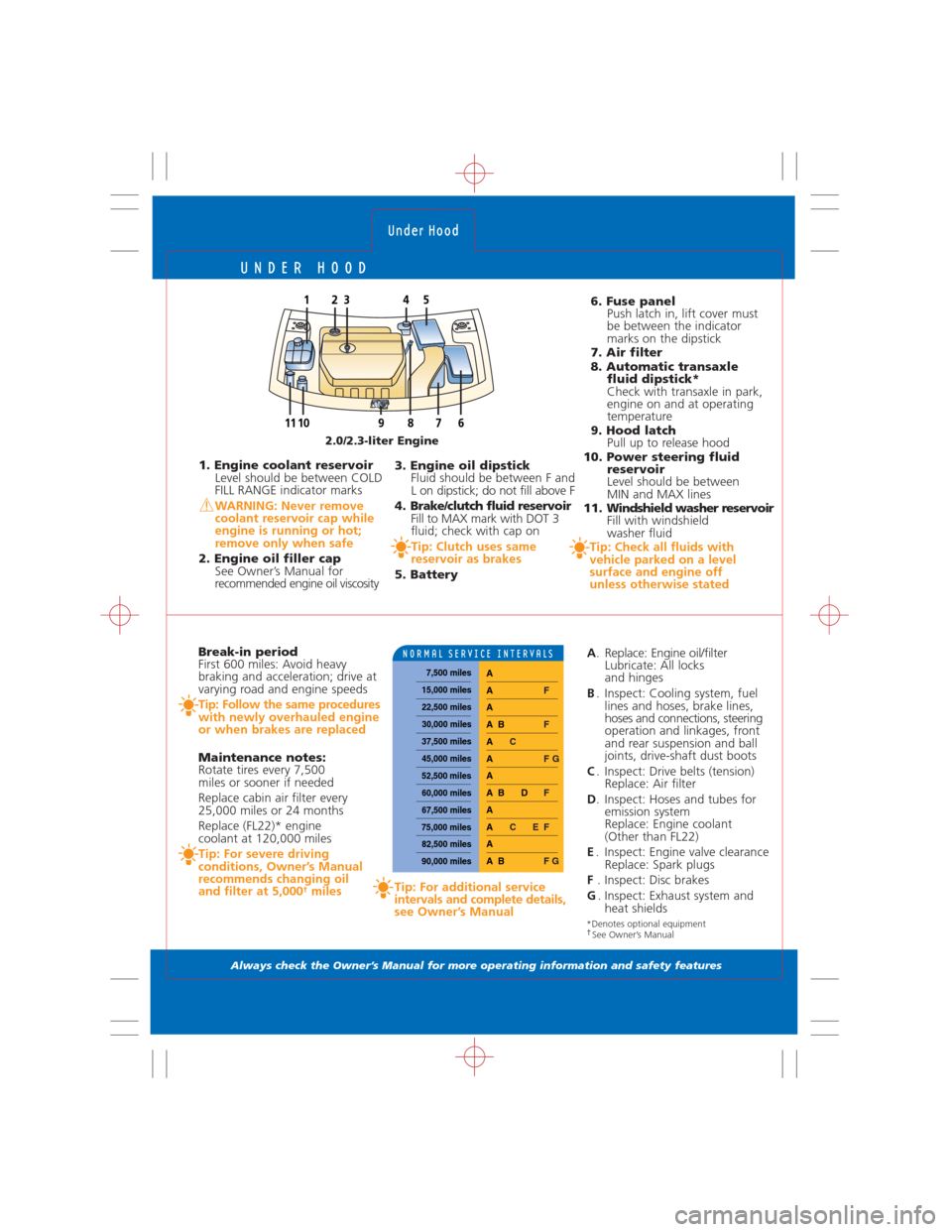
UNDER HOOD
Always check the Owner’s Manual for more operating information and safety features
Under Hood
1. Engine coolant reservoir
Level should be between COLD
FILL RANGE indicator marks
WARNING: Never remove
coolant reservoir cap while
engine is running or hot;
remove only when safe
2. Engine oil filler cap
See Owner’s Manual for
recommended engine oil viscosity
Break-in period
First 600 miles: Avoid heavy
braking and acceleration; drive at
varying road and engine speeds
Tip: Follow the same procedures
with newly overhauled engine
or when brakes are replaced
Maintenance notes:
Rotate tires every 7,500
miles or sooner if needed
Replace cabin air filter every
25,000 miles or 24 months
Replace (FL22)* engine
coolant at 120,000 miles
Tip: For severe driving
conditions, Owner’s Manual
recommends changing oil
and filter at 5,000
†milesTip: For additional service
intervals and complete details,
see Owner’s Manual
3. Engine oil dipstick
Fluid should be between F and
L on dipstick; do not fill above F
4. Brake/clutch fluid reservoir
Fill to MAX mark with DOT 3
fluid; check with cap on
Tip: Clutch uses same
reservoir as brakes
5. Battery
A. Replace: Engine oil/filter
Lubricate: All locks
and hinges
B. Inspect: Cooling system, fuel
lines and hoses, brake lines,
hoses and connections, steering
operation and linkages, front
and rear suspension and ball
joints, drive-shaft dust boots
C. Inspect: Drive belts (tension)
Replace: Air filter
D. Inspect: Hoses and tubes for
emission system
Replace: Engine coolant
(Other than FL22)
E. Inspect: Engine valve clearance
Replace: Spark plugs
F. Inspect: Disc brakes
G. Inspect: Exhaust system and
heat shields 6. Fuse panel
Push latch in, lift cover must
be between the indicator
marks on the dipstick
7. Air filter
8. Automatic transaxle
fluid dipstick*
Check with transaxle in park,
engine on and at operating
temperature
9. Hood latch
Pull up to release hood
10. Power steering fluid
reservoir
Level should be between
MIN and MAX lines
11. Windshield washer reservoir
Fill with windshield
washer fluid
Tip: Check all fluids with
vehicle parked on a level
surface and engine off
unless otherwise stated
15
91110786
423
2.0/2.3-liter Engine
*Denotes optional equipment†See Owner’s Manual
NORMAL SERVICE INTERVALS
7,500 miles
15,000 miles
22,500 miles
30,000 miles
37,500 miles
45,000 miles
52,500 miles
60,000 miles
67,500 miles
75,000 miles
82,500 miles
90,000 miles
A BF G A A
C E F A A
B D F A A
F G A C A
BF A A F A